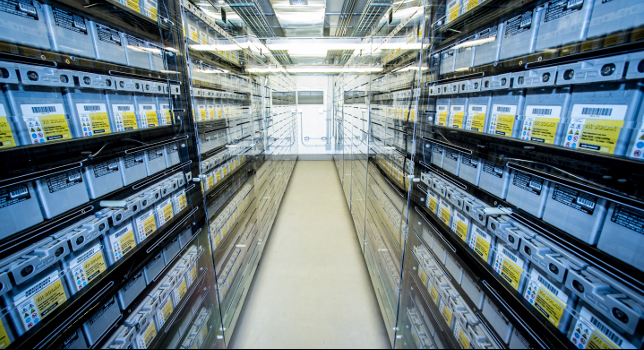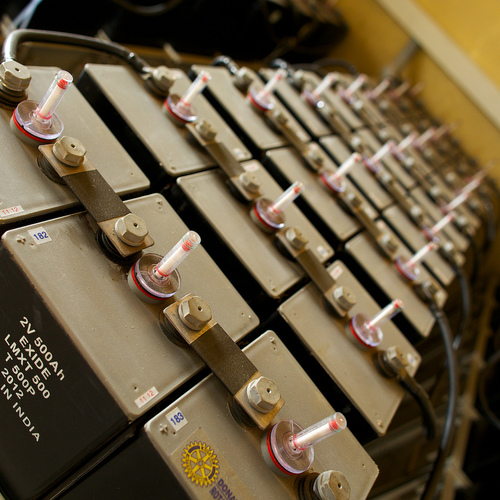Image Credit: GridSolar
Image Credit: GridSolar These storage containers house batteries that are charged overnight when demand on the grid is low and then placed in readiness for high summer demand the following day.
Image Credit: GridSolar Thermal storage also is part of the mix. Boothbay's pilot program also includes equipment that makes ice overnight, when electric rates are low, and uses it the following day to supplement air-conditioning equipment for businesses.
Image Credit: GridSolar
Three shipping containers parked in the industrial park of this midcoast Maine community contain 600 batteries that collectively have enough capacity to power 100 houses for a day. The batteries are part of a comprehensive pilot program designed to prevent transmission lines in the area from overloading in summer.
According to an article in the Portland Press Herald, the battery array is the first utility-scale storage system for electricity in New England.
Batteries and other storage and generation devices can help even out the load on the grid by feeding in electricity at times when solar or wind output drops and demand is high.
In Boothbay, the sealed glass-mat batteries are charged at night when demand for electricity is fairly low. In the morning, the batteries are ready to provide electricity when and if they are needed, the Press Herald reported.
The batteries are part of a pilot program called GridSolar that’s designed to keep power lines from being overloaded on hot summer days when the Boothbay peninsula is packed with tourists, and hotels, restaurants, and shops are drawing a lot of power. In addition to the batteries, the pilot program has seen the installation of thousands of LED lights, the deployment of photovoltaic panels with a total rated capacity of 250 kW, and a thermal storage system in which electricity is used to make ice at night to supplement air conditioning during the day.
In all, the newspaper said, these measures can produce and/or conserve 1.8 megawatts of electricity.
Less expensive than new transmission lines
The pilot project is being run by GridSolar LLC in Portland, Maine, for the Maine Public Utilities Commission. It was developed in a partnership led by Convergent Energy + Power of New York City.
Convergent didn’t disclose the price of the battery system, but GridSolar said in a filing that the energy costs three times as much as the net price of solar and five times as costly as conservation measures, the newspaper said. Even so, the cost to ratepayers is only a third of the $18 million it would cost to build a new transmission line to the community. Boothbay Harbor is at the end of a peninsula, 10 miles from the major coastal highway, Route 1.
GridSolar points to a variety of advantages for Maine from what it calls the “smart grid platform.” They include a reduction in greenhouse gas emissions, enhanced business opportunities, and lower electric rates.
“Technologies like this are fairly small, but they respond very fast,” Steve Rourke, vice president of planning at New England’s grid operator, told the newspaper.
New England saw 900 megawatts of PV installed last year, which could double by 2023. Wind energy is expected to match that.
“The more solar we see, the more wind we get, it could become more important to use batteries to ride through the variability, minute to minute,” Rourke told the Press Herald.
Weekly Newsletter
Get building science and energy efficiency advice, plus special offers, in your inbox.















7 Comments
Now if
we could just get some solar panels that respond to dark...
about time
Utility-scale battery buffers are long overdue.
Lead-acid, huh? ... http://cdtechno.com/product/vrla/vr_solar.html
I guess they're still too leery of committing to lithium for something
like this.
_H*
Grid batteries have different specs...
Grid batteries have different specs for different purposes, and there are competing chemistries for different applications, and different price points. eg. Flow batteries are pretty good for storing lots of power in a small space at an attractive price, but don't have sufficiently fast response time to be useful for frequency control or voltage stabilization purposes. Lead acid has many variants too ( with different characteristics), is currently more available than lithium ion (but that may be changing), and more general-purpose than flow batteries.
Variations on lithium ion isn't ideal for every grid application though there is a broad range out there, and the range of goods is changing by the hour.
California has created a large US market for grid storage with a massive mandated amount to be installed by 2020 (on both sides of the meter), only half of which may be owned by the utilities. The rapid evolution of this market, what's actually needed & where, and what really makes sense (or not) is a hot topic this past year or two on the usual utility-biz blogs, eg:
http://www.greentechmedia.com/search/results/eyJyZXN1bHRfcGFnZSI6InNlYXJjaFwvcmVzdWx0cyIsImtleXdvcmRzIjoiY2FsaWZvcm5pYSBzdG9yYWdlIG1hbmRhdGUifQ
http://www.utilitydive.com/news/where-is-the-us-energy-storage-market-going/373479/
http://www.utilitydive.com/search/?q=storage+
New England Utility Scale Battery Storage
Two items catch my eye on the storage battery project. All-in-all, I'm glad to see additional testing of storage so we can carefully document the benefits as well as the cost-in-use of the technology. Maybe the economics are better than they appear ... or ... not as better .
ITEM I) "... didn't disclose the price of the battery system but Grid Star said that the energy costs 3x as much as the net price of solar and 5x as costly as conservation measures ... "
a) Conservation sounds irresistible. I wonder what MEASURES they had in mind?
b) As expected, their main problem is said to occur on hot summer days. An option would be to address the heat gain directly, thus moderating the apparent peak electricity demand.
c) I wonder what cost for PV they were using? (The cost reports for PV seem to drop monthly).
ITEM II) " ... The more solar we see, the more wind we get, it could become more important to use batteries to ride through the variability ... "
d) If they are correct (the odds seem good), the storage component sounds like a hidden but potentially necessary cost for these desirable green energy generation methods.
Response to WD
WD,
I can imagine that conservation measures -- for example, fitting shading devices on west-facing windows -- might be much cheaper than installing three shipping containers full of batteries. But it's hard for a utility to motivate homeowners to implement conversation measures.
You just have to give them money (response to Martin)
Automated demand response (automatically turning things off/down) are dead-easy with current technology. Programs to aggregate and COMPENSATE things like turning the AC thermostat up 2F during grid congestion/peak load times have been started and proven, but the D.C. District court vacated FERC order 745 where that demand response could be bid into capacity markets, taking some of the compensation out of it. The US Supreme Court has agreed to hear the appeal, but that's going to be one of the wonkiest arguments heard in awhile.
If small-load demand response utilizing smart thermostats like the Nest, etc becomes standardized and WHERE NEEDED to relieve the most susceptible grid congestion points, and COMPENSATED adequately a lot of fine-tuning of the grid could happen for essentially zero capital cost, some capacity payments costs (which will bring capacity market costs down, because turning things down/;off is cheap compared to maintaining and operating low capacity-factor peaker plants, etc), it wouldn't cost the ratepayers a thing, rather it would save every body money.
Not all regional grid have capacity markets where demand response can be compensated, but it's become a valuable tool in the NY-ISO, and ISO-NE grid operating regions over the past few years. It's easy, it's cheap, but owners of power generating assets take a hit in the wallet, because the price of peak power becomes limited.
A battery can have similar effects on peak power market prices, and can supply services that demand response alone cannot. But demand response it going to become ubiquitous. Electric hot water heaters that are "grid aware" (== controlled by the utility) don't have to meet the same raw efficiency standards, but can be used to stabiize local grids in the age of widely distributed generating assets (like roof top PF) by turning the HW heater into fairly finely controlled power dump, which can be used even-out the line voltage.fluctutions in a very localized fashion. This too is MUCH cheaper than using batteries for those services, but there's a limited amount it can do from a larger scale peak demand point of view, where a lot of load might need to be shed for an hour for the grid generators to keep up or to relieve the load on feeder lines, etc.
http://www.esource.com/ES-WP-18/GIWHs
But demand response across a spectrum of widely distributed and different types of loads works beautifully when done right. Hopefully the Supremes will reinstate FERC order 745 to better incentivize these types of programs, since it's SO much cheaper than the alternatives. (And WAY cheaper than a bunch of heat rejecting shades for providing grid-relief.)
Response to Dana Dorsett
Dana,
From the utility's perspective, there is no downside to "demand response" measures -- otherwise known as remote-controlled appliances (...that are controlled by the utility).
It remains unclear whether the average homeowner will be as thrilled as the average utility to know that their air conditioner or water heater is being turned on and off by Consolidated Edison. Even if the homeowner is offered compensation, many people will say, "I don't want that to happen."
For more on this issue, see Get Ready for Smart Appliances.
Log in or create an account to post a comment.
Sign up Log in